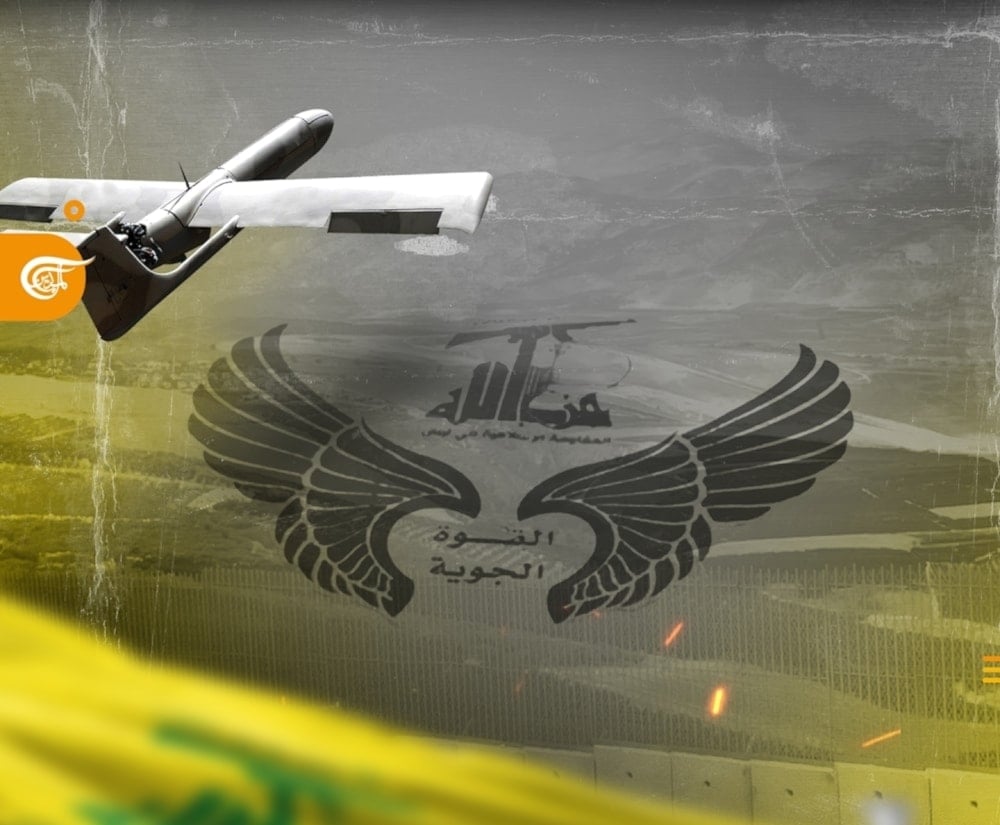Israeli report: Drone that struck Binyamina was a Sayyad-107
The drone was part of a larger, coordinated aerial attack by Hezbollah, which launched short-range rockets toward northern occupied Palestine.
-

The logo of the Hezbollah's Air Defense Force. (Al Mayadeen)
The Hezbollah drone that struck an Israeli army training base on Sunday evening, killing four soldiers, briefly disappeared from radar before reappearing and hitting its target, according to the initial findings of the Israeli Air Force’s investigation, as reported by Israeli media.
The drone was reportedly part of a larger, coordinated aerial attack by Hezbollah, as the resistance movement launched short-range rockets toward northern occupied Palestine, fired three precision rockets aimed at Haifa, and deployed three drones in the assault.
An official investigation revealed, as per Israeli media, that the explosive-laden drone struck the base during dinnertime, and it is believed that the timing and location of the attack were deliberately chosen to maximize casualties.
In further detail, the investigation unmasked that the electronic warfare measures were unsuccessful in causing the UAV to lose course. It disappeared from radars 30 miles (48 km) northeast of Akka, leading the Israeli Air Force (IAF) to believe it had crashed.
The IAF investigation revealed, as per Israeli media, that the drone briefly reappeared on radar for about a minute during the 30-minute window between its disappearance and the strike. However, at the time, Israeli forces did not recognize it as a drone, so no sirens were triggered.
In response to the incident, the Air Force increased the scope of its warning zones, which will result in more sirens and a higher likelihood of false alarms, according to Israeli media. Additionally, the Air Force will now assume that a drone remains airborne when it disappears from radar, only concluding that it has crashed if concrete evidence is found.
Furthermore, the Israeli Broadcasting Authority reported that the army's investigation revealed that the drone is a Sayyad-107, and is equipped with a warhead containing 3-5 kg of explosive materials.
Hezbollah drone strike exposes gaps in 'Israel's' air defense: AP
The Associated Press reported on Monday that Hezbollah's recent drone operation exposed significant vulnerabilities in "Israel's" security systems.
The attack, which killed four Israeli soldiers and wounded dozens highlighted gaps in "Israel’s" multi-layered air defense, as the aircraft bypassed detection.
Hezbollah claimed responsibility, stating the drone successfully penetrated Israeli radar as part of a broader strategy involving simultaneous missile and drone launches.
Read more: Four dead, dozens injured in Hezbollah drone attack on IOF Haifa base
The AP described the strike as one of the worst mass casualty incidents in "Israel" in a year of its ongoing war on the Gaza Strip, surpassing the impact of dozens of Iranian ballistic missiles and repeated rocket barrages from Hamas and Hezbollah. The report emphasized that this massive impact was caused by "a single drone."
This strike follows a series of similar attacks in recent weeks, revealing "Israel’s" ongoing struggle to combat drones, which are more difficult to detect and intercept than rockets or missiles due to their smaller size, slower speed, and use of plastic components.
"We already have six dead in the past 10 days from drones. That’s too much," said Ran Kochav, a former head of the IOF's aerial defense command, emphasizing that drones "have become a real threat."
Kochav explained that "Israel" had spent years prioritizing its air defense systems to counter rockets and missiles, while drones were not initially considered a significant concern.
'Hezbollah drones erode Israel’s air-defense capabilities'
As a result, "Israel’s" ability to detect and intercept drones has fallen behind its more advanced defenses against rockets and missiles.
"We were busy in recent years ... and unmanned (aerial vehicles) was not a top priority," he said. "The results unfortunately are not good."
Israeli officials have been reportedly investigating how the drone evaded detection, with Security Minister Yoav Gallant vowing to learn from the strike and said "Israel" has been "concentrating significant efforts in developing solutions" to tackle the drone issue.
According to Tal Beeri, the director of research for the Alma Research and Education Center, "Hezbollah in May used for the first and only time a drone that was able to fire an anti-tank missile and that it may possess more."
He added, "Hezbollah has also used drones to erode Israel’s air-defense capabilities by slamming them into the very batteries and infrastructure meant to take them down."
'Israel' lacks effective interception system
In the wake of the operation, Israeli news outlets on Monday described Hezbollah's attack as "difficult, disturbing, and problematic," according to a report by the Israeli Maariv website.
Another news website, The Israel Hayom, reported that 52 Israeli soldiers from the Golani Brigade remain hospitalized, with several in critical condition.
"Israel" currently lacks a dedicated interception system to handle drones launched from Lebanon, Gaza, Syria, Iraq, Iran, and Yemen, Maariv emphasized.
Maariv explained that the chances of downing a drone are lower than intercepting missiles, and this is why Hezbollah and other factions have chosen this weapon, stressing that the Israeli military "must act defensively" to bring down these drones.
Read more: Israeli settlers describe chaos after deadly Hezbollah drone strike
The newspaper recalled Hezbollah’s April attack using a combination of anti-tank guided missiles, rocket-propelled grenades, and two suicide drones. It also referred to two explosive drones that struck Hurfeish a few months later and another attack in the same month when an explosive drone targeted northern Golan.
Maariv cited Rotem Meital, CEO of Asgard Systems in Tel Aviv, which develops military technology for the Israeli defense industry, as saying that drones, by nature, have a particularly challenging radar signature, especially when flying at low altitudes, which complicates radar detection.

 6 Min Read
6 Min Read








